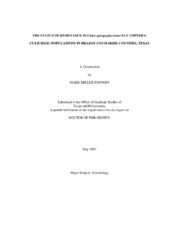| dc.description.abstract | In 2002, West Nile virus was isolated for the first time in Harris County, Texas.
The subsequent epidemic led the Harris County Mosquito Control Division to initiate an
extensive spraying operation to suppress infected adult mosquitoes. The control
program was aimed at the predominate disease-carrying mosquito for the southern
United States, Culex quinquefasciatus Say. With the increase of insecticide pressure on
the mosquito populations, the possibility of resistance was brought into question. A
three year study using a vial bioassay test was conducted in Harris (2004-2005) and
Brazos (2005-2006) counties to determine the resistance status of Cx. quinquefasciatus
to the six chemicals (malathion, naled, resmethrin, permethrin, sumithrin, and
pyrethrum) used most frequently in adult mosquito control programs.
The resistance ratios acquired from the vial bioassay tests were mapped onto
shapefiles for Harris and Brazos counties, which revealed clustering of areas with
pyrethroid resistance mosquito populations in the northeastern, southeastern, and
southwestern corners of Loop 610 in Harris County. An additional six-month
preliminary study, involving six operational areas in Harris County and three in Brazos County, was conducted, demonstrating only minor fluctuations in the monthly resistance
ratios occurring in both counties in 2005.
A significant correlation was documented between the two years of resistance
ratios for mosquitoes to the three pyrethroids in Harris County and all the insecticides
except pyrethrum in Brazos County. A significant relationship was also found between
the resmethrin resistance ratios and the number of spray events performed during the
previous year and the malathion resistance ratios with the insecticide treatments
conducted in the same year. The correlation analyses provide data used to predict areas
where resistance can develop in the mosquito population, thus providing the control
agency more data to plan future control tactics.
The overall analysis indicated that Harris County has localized pockets of
resistant mosquitoes; but, on a whole, it does not seem to have widespread resistance in
its mosquito populations. The only resistance that was detected was in the mosquitoes
tested against the three pyrethroids. Mosquitoes in Brazos County, which has no
organized mosquito control, demonstrated county-wide susceptibility to all six
insecticides tested. | en |


